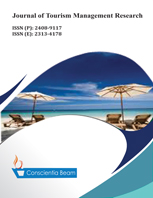Resource transmission from financial development to tourism growth: Evidence from selected South Asian countries
DOI:
https://doi.org/10.18488/31.v10i1.3399Abstract
Tourism has become one of the fastest-growing industries in South Asia, contributing to a variety of development goals such as income generation, poverty reduction, employment, foreign currency earnings, and better living standards. On the other hand, financial development (FD) accelerates the growth of developing sectors by providing necessary access to finance. Therefore, this study explores the mechanism of resource transmission from FD to the tourism industry in selected South Asian countries, India, Bhutan, Bangladesh, Sri Lanka, and Nepal. The second-generation cross-section augmented unit root tests CIPS and CADF confirm the stationarity property of the variables. LM bootstrap and Durbin-Hausman cointegration tests find the long-run association among the variables. The D-H panel causality test reveals bi-directional causality between financial development and the tourism industry. The long-run cointegrating factor for financial development is found to be positive (1.03, 1.25, and 0.89 respectively) and significant in the PDOLS, PMG-ARDL, and Cup-FMOLS estimations. The results indicate that financial development enhances the tourism industry development supporting tourism-led led growth hypothesis. The study also recommends policy measures that will help to shape the policy implication for this region.

